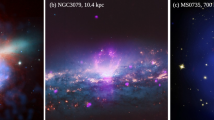Abstract
We are making precise determinations of the abundance of the light isotope of helium, 3He. The 3He abundance in Milky Way sources impacts stellar evolution, chemical evolution, and cosmology. The abundance of 3He is derived from measurements of the hyperfine transition of 3He+ which has a rest wavelength of 3.46 cm (8.665 GHz). As with all the light elements, the present interstellar 3He abundance results from a combination of Big Bang Nucleosynthesis (BBNS) and stellar nucleosynthesis. We are measuring the 3He abundance in Milky Way H ii regions and planetary nebulae (PNe). The source sample is currently comprised of 60 H ii regions and 12 PNe. H ii regions are examples of zero-age objects that are young relative to the age of the Galaxy. Therefore their abundances chronicle the results of billions of years of Galactic chemical evolution. PNe probe material that has been ejected from low-mass (M≤ 2M ⊙) to intermediate-mass (M∼2–5M ⊙) stars to be further processed by future stellar generations. Because the Milky Way ISM is optically thin at centimeter wavelengths, our source sample probes a larger volume of the Galactic disk than does any other light element tracer of Galactic chemical evolution. The sources in our sample possess a wide range of physical properties (including object type, size, temperature, excitation, etc.). The 3He abundances we derive have led to what has been called “The 3He Problem”.
Similar content being viewed by others
References
R. Bachiller, T. Forveille, P.J. Huggins, P. Cox, Astron. Astrophys. 324 1123–1134 (1997)
D.S. Balser, T.M. Bania, R.T. Rood, T.L. Wilson, Astrophys. J. 483, 320–334 (1997)
D.S. Balser, T.M. Bania, R.T. Rood, T.W. Wilson, Astrophys. J. 510, 759–783 (1998)
D.S. Balser, R.T. Rood, T.M. Bania, Astrophys. J. 522, L73–L76 (1999)
D.S. Balser, W.M. Goss, T.M. Bania, R.T. Rood, Astrophys. J. 640, 360–368 (2005)
T.M. Bania, R.T. Rood, D.S. Balser, Nature 415, 54–57 (2002)
A.I. Boothroyd, I.-J. Sackmann, Astrophys. J. 510, 232–250 (1999)
C. Charbonnel, Astron. Astrophys. 282, 811–820 (1994)
C. Charbonnel, Astrophys. J. 453, L41–L44 (1995)
C. Charbonnel, Space Sci. Rev. 84, 199–206 (1998)
C. Charbonnel, J.D. Do Nascimento, Astron. Astrophys. 336, 915–919 (1998)
C. Charbonnel, J.A. Brown, G. Wallerstein, Astron. Astrophys. 332, 204–214 (1998)
C. Charbonnel, S. Balachandran, Astron. Astrophys. 359, 563–572 (2000)
D.S.P. Dearborn, J.C. Lattanzio, P.P. Eggleton, Astrophys. J. 639, 405–415 (2006)
P.A. Denissenkov, A. Weiss, Astron. Astrophys. 308, 773–784 (1996)
P.P. Eggleton, D.S.P. Dearborn, J.C. Lattanzio, Sci. Express (2006). 10.1126/science.1133065
D. Galli, F. Palla, F. Ferrini, U. Penco, Astrophys. J. 443, 536–550 (1995)
D. Galli, L. Stanghellini, M. Tosi, F. Palla, Astrophys. J. 456, 478–498 (1997)
J. Geiss, in Origin and Evolution of Elements, ed. by N. Prantzos, E. Vangioni-Flam, M. Casse (Cambridge Univ. Press, Cambridge, 1993), pp. 89–106
G. Gloecker, J. Geiss, Nature 381, 210–212 (1996)
C.J. Hogan, Astrophys. J. 441, L17–L20 (1995)
A. Palacios, C. Charbonnel, M. Forestini, Astron. Astrophys. 375, L9–L13 (2001)
F. Palla, D. Galli, A. Marconi, L. Stanghellini, M. Tosi, Astrophys. J. 568, L57–L60 (2002)
R.T. Rood, T.M. Bania, T.L. Wilson, Astrophys. J. 280, 629–647 (1984)
R.T. Rood, T.M. Bania, T.L. Wilson, D.S. Balser, in ESO/EIPC Workshop on the Light Elements, ed. by P. Crane (Springer, Heidelberg, 1995), pp. 201–214
D.A. Roshi, D.S. Balser, T.M. Bania, W.M. Goss, C.G. De Pree, Astrophys. J. 625, 181–193 (2005)
I.-J. Sackmann, A.I. Boothroyd, Astrophys. J. 510, 217–231 (1999)
G.J. Wasserburg, A.I. Boothroyd, I.-J. Sackmann, Astrophys. J. 447, L37–L40 (1995)
A. Weiss, J. Wagenhuber, P.A. Denissenkov, Astron. Astrophys. 313, 581–590 (1996)
M. Tosi, in The Light Elements and Their Evolution, Proceedings of IAU Symposium 198, ed. by L. da Silva, M. Spite, J.R. de Medeiros (ASP, San Francisco, 2000), pp. 525–532
J.P. Zahn, Astron. Astrophys. 265, 115–132 (1992)
Author information
Authors and Affiliations
Corresponding author
Rights and permissions
About this article
Cite this article
Bania, T.M., Rood, R.T. & Balser, D.S. The Milky Way 3-Helium Abundance. Space Sci Rev 130, 53–62 (2007). https://doi.org/10.1007/s11214-007-9144-z
Received:
Accepted:
Published:
Issue Date:
DOI: https://doi.org/10.1007/s11214-007-9144-z




